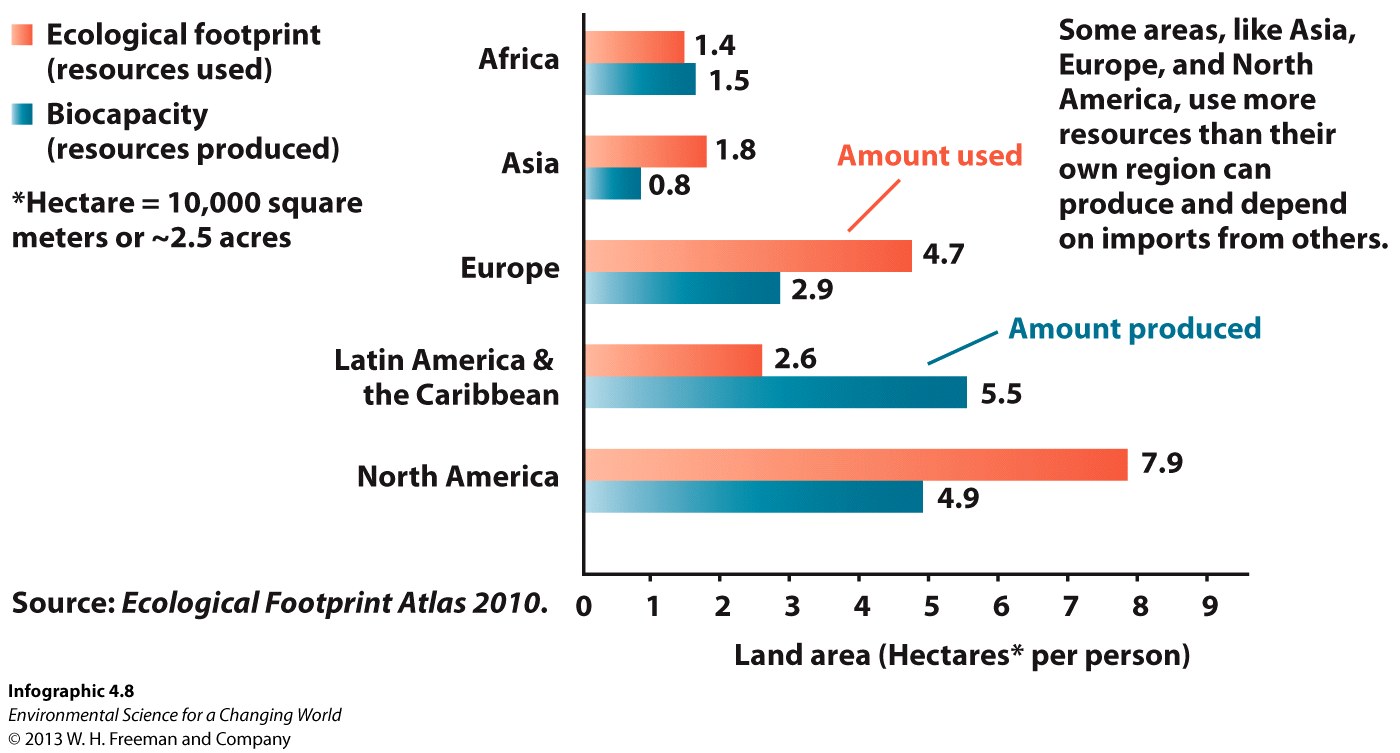Chapter 4. Chapter 4: Human Populations
What impact does our current world population have on the Earth...

Guiding Question 4.5
What impact does our current world population have on the Earth and can it support us all?
Why You Should Care
The industrialized countries of the world now have the hindsight to realize that the road to development did not follow a very environmentally friendly course. It is difficult for developed nations to encourage ecologically responsible development in developing nations, since developing countries have and use a disproportionate share of the world’s resources. There aren’t enough resources in the world to allow everyone on the planet to consume them at the current rates of developed countries, so understanding the interplay of culture, development, and population growth is crucial to eventually finding a sustainable high standard of living for everyone.
Question Test Your Vocabulary
Select the correct term to match each of the following definitions:
| Term | Definition |
|---|---|
| P4AlT5lciup9HtW/vUYvZM1zaW6ROpICGmIkMIpBc4kihuhvSGuCwUKRBihv+LvUM4ZhL3kgagDlj8Fmh3/D4UThdH5QBtrUYrXMbUYloxl1DCk4db9ZS+mHNdXn32tDU27bWTndr7EGotVo6YXosaismTfFHytpJ8A/TcF2kDT42Icjmcv7W5HVWNgbTcv1w0uR1f8gtFg= | The movement of people into a given population. |
| QYln0hjxhAt17p3qEdv04cUAKhizTxUTlNxIm07oY409M+7EEamxVRPEoSa868cJPmgSM74hHe3naJe9ZolIuUONr9au+8LWblB79hHjGdQw4Mr02cVsxriNWIowEDOMnsPJAuIFxM6CNn6cg7ibm4sxRdq6zaa0WqXk3RzBrXi08OqK+0iDt+panlKjalU3z//Ox87mxPY= | The movement of people out of a given population. |
| VOALno+L3oRj1jpIIyYgVcGdWPzCKRueadlL9LhW2opiHfIKK6jTa2DHm1RRxYrZCuFEru/PsCAnqFKanmRdGRj1LPk8CDUQiiD6ogaQozn3mz7KIsIiZuuMOvRXF2akYVznWoHoK2oPDNvifoe41yj45o7hFTIhQzr4YabV9/iDTtq9cAY31EzcvJNdVx/xl/C8lZa5Fv0= | More people living in an area than its natural and human resources can support. |
| NyfuKInpwq5iy4CoGrX+cvZK9PO+dvu44YNwYlBFgBbWsAOQtFk+152QPUcl77GPRW0kosQihh84JIZAV+Vp89nGYcpWbKP5Mkbt0LtwZeOnEccQh4sqKkomDn+dxnJjzFWZ5UcUumh1m33Mp80/U+/aXRyMJ8i8KlWZseJnqOzT7RU7UHe6odYUComO9+ivUKRIHvH8+uE= | The systematic killing of a specific gender (male or female) |
| hyNA2OaYwm6I39DLPfLIX8Ub8ARC0dSQAaBwaspf6z9k/WAGG0XPS8ODfGbZ/1lGUcprrWYYwuI1vDsrHBnppC1geKQiQmqSNFIPJy/3Op5Q5CYUXAVY11DDz5wIiyNzRsyBAJuI3QwgimJpHxGPbLEiLh5KlSJuIn0SztMXkACkHAVDo9AJb2Gw0y5P2O2gbVdjrjPmhhY= | The population size that an area can support for the long term; it depends on the resource availability and the rate of per capita resource use by the population |

Question Sequence
Question 4.1
rDmH3yFL4r14w55KIZynO1i2Hh7s0lmN5Qf3A7ObMcrqTtiU2jqegaLuxSlSAcc+x8CwgT5z/X3XSM8ke+QBwhHnM5GXzKB2V6rR8qFbUcVWj9cLB7TiE6Zxr066hiJJ4PCeuSS65KjFiuXLIbry0ULUSfqbAi2DLXufeXiyJEVfw0eeQuestion 4.2
GzuHUpJ0a8YC2UyVgtzclglYVkzO5abQwOHJf3W3ulb38XpNlsmRF/7arwj2IjdR9p1z9TnuXwtii/CAO6SQzzsDJ0yIoHO2OnbUDR9MAO6TQvkUKIxvZ9qOtvVu071Fww0W0XHfySbyOVn5VvVeI7eOq4tS2DpWHuFbHpyf7HdyTw2NQuestion 4.3
Latin America & the Caribbean, and Africa are the only two regions where the resources produced per person exceed the resources used. In which region do resources used most exceed the resources produced? N9pYV5f+V5atKcYQ5YcLdj8fUUtnUl9sAV0fl9yZYvJQMu8K
Question 4.4
uVjbOiS9IQZOfIUuSuAk38E6zDRYxYnYfZe9de0gVcxu5unm36jccCpcRWVPhyk95OrYTIhVJB5lB/k42UKxYBdzLEV5M3DJd8+/byc/asg8uEgDKrRBEkoZ4IgCwcI4BbxpBFAvQ9P99Q+QKpcB/E3fsgbw8YAV65MzxaL8K7FazX7vGc0EeL3ewuOuB7PP2KeoiKtAWetYXnlUHAabwKSI22kPzoq5BfzTx98ivJjV3/6kR+Bx7Jxyy/njmLpEwU18yIkctgE08aq7wVIJQkDfrO+qxQcT83FPQcmZ1hu+NQU3VHS05r9BtWsOuOZ/22/oYGJV96J/ZE/Bm8pHteHFKm6Gv8rC6w3+DpXsBeqC8GfS7CmBh1gi8cV6//bcYfWJ2003X/9jvxC7TpupJWYLdQMMPaNiXEAYnxTeqOidsGFhvjTjMTdJoWVhSZV7+wMgueoSIQcgRGtm937rW3RrSWp0HuyXY+ykgFE+0d4h7Ut6bX8R5tCAfA/SgksMv4s1nA==Question 4.5
t+k/1pEQD0eUGn2Yp1oCLjQfMxKPixutySYqajl0Q/r7nW4E9rn2fNULOcEQAOWGy47vyFuZMChiOuWAnjGR+VVxLz4z6kJ3nUofn4EBm/Nr2SD89JYPPf0YDOqkE8IG3Mm95CrM9pU8VE9DzLnEP9/KsNYhlZdbzsIc99Q6Twmb0HTjs5IVeQJtvGKCeNhdQuestion
Short-Answer Questions
Let’s shift our focus from China to the United States. Although not the most populous nation, the U.S. is demographically exceptional in other ways. Answer the following thought questions about population growth in the U.S. To help find specific facts, you may want to consult the Central Intelligence Agency World Factbook or another reputable website.
IZ7lYb33rqfW/GkCt2UNxPDJjF4LklPuwc1FHfri5RnSM+JI2BD46CrmsX5V1vWJn9IBkdOJW+VWrUW0JLIPCaEFBXUdSDgXHN847JZ9HIY4li2BRzYNpwaGSJboxHyPEgtjL6pzvJy8grhl25+/SnRSgPV9fmYQwCxc0cVw1pi4Esg037wThhDfvCD6478rv6Cz0cOEYRLHYKAaPF0dkFQmgbVqtz4BxLR26Hoals/hAor9q86MoBWK23ki5030GmH2K1CFmV0WLvo43hRU2mXqhOnFO9okwVs3PmcscLaROrKI4u3E/LNcpoJu1TIh45/d3CGXZjJeQ/0gwHWWeSJgXMMev14yp5Tg+c+Cb33gInMHz4RjWoslubOca8PfbtDYtjGqexvdzCkfJTeJg3OxjEZ9ab61DteH6dE96G5s5/VwTWQRimdP3I8kngjWO96S3s17BKzsyk1iUyTajhRt05Me6aM7 DYEXMDLgVPlCTPcMus5aQT4kq90HmDrmrpphWFL82rZpGLgDpdGR1b+tgh+0HXg2XXfvt7xrW3uqdO/bkeXBVwOif8bhaoOoPlUxA+U2hcHx0vgENrqule4t90/qOSLlM7Xmuip1nZeunePDRFT5s7PavWNlF0IBEvcdQ117El2SYXuCh30cP15uznfNJKRCKh1KTTOCTJR9zQnh0x+O6UzOdXq32Fd+yKhEdKiuC4P9tClbciDGcsn10M3p/OLVudHmhSxql2jgy7nhnrmkv921UOk9Agb86BOmuBcPWPRcn2IZZcGMrxUNCpd3Q4yqDLMY4wxVI4VegurSLgYpqhkkA4NuJnPHLBHyhLeu22EQeVm47rtQnZM+yQYSaWYJF93r0bagzYSqWCWZ3UR8MJC17wu7TOmn iI5u+EWIep0p996FZUItbek3e0Qsk8FMWllzULBUhZHwvqf5MXZveGr5kduZbrqw2PLrm9i0ojUBuzPjmMTuq4KKMNqQ2g0h5G4ANrm+mqQSJ+f7hmOHbSjKmZYm9pc7C9mzrfjV/x9+FvooU0THF4C5Xz9fVhs7vEKzvnWF8MYEAE21M1Xv+yRTh71ETEd/FSIZO9mmAhNIz08SbO/PjqvI0KE=Some facts about the US that shed light on its TFR:
- The US has higher rates of teen pregnancy than most of the developed countries of Europe.
- The US is more religious than the countries of Europe, and studies show that the more religious a country is, the higher its TFR will be.
2) There are many approaches to take with this question. The U.S. has gone through the transition in that birth rate has lowered to approach death rate but there are many things one could point to as indicating that the standard of living has not improved to the same level as other developed countries.
3) Birth rates in the U.S. decreased for most of the 1800s, but the total fertility rate really dropped around 1900 and then increased during the post WWII baby boom (when the standards of living and urbanization also increased).